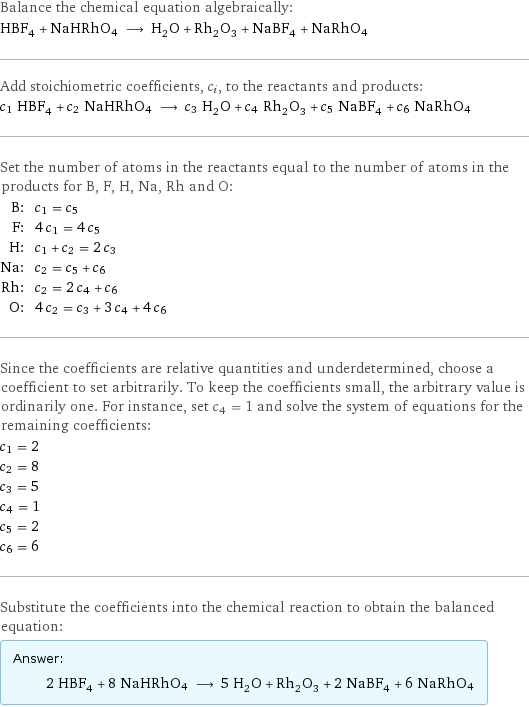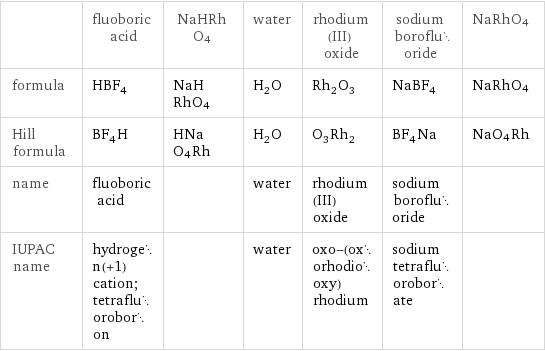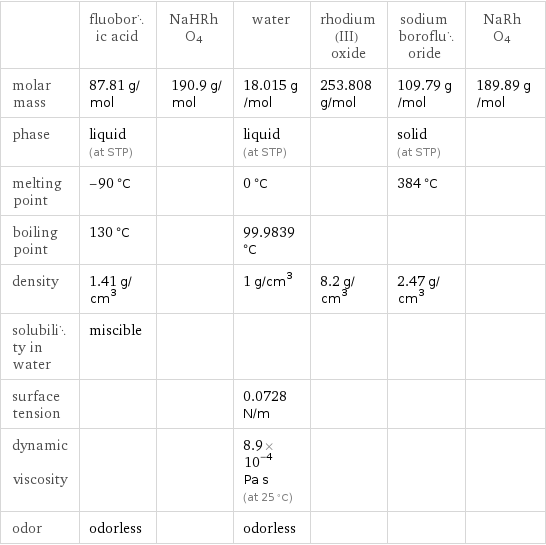Input interpretation

HBF_4 fluoboric acid + NaHRhO4 ⟶ H_2O water + Rh_2O_3 rhodium(III) oxide + NaBF_4 sodium borofluoride + NaRhO4
Balanced equation

Balance the chemical equation algebraically: HBF_4 + NaHRhO4 ⟶ H_2O + Rh_2O_3 + NaBF_4 + NaRhO4 Add stoichiometric coefficients, c_i, to the reactants and products: c_1 HBF_4 + c_2 NaHRhO4 ⟶ c_3 H_2O + c_4 Rh_2O_3 + c_5 NaBF_4 + c_6 NaRhO4 Set the number of atoms in the reactants equal to the number of atoms in the products for B, F, H, Na, Rh and O: B: | c_1 = c_5 F: | 4 c_1 = 4 c_5 H: | c_1 + c_2 = 2 c_3 Na: | c_2 = c_5 + c_6 Rh: | c_2 = 2 c_4 + c_6 O: | 4 c_2 = c_3 + 3 c_4 + 4 c_6 Since the coefficients are relative quantities and underdetermined, choose a coefficient to set arbitrarily. To keep the coefficients small, the arbitrary value is ordinarily one. For instance, set c_4 = 1 and solve the system of equations for the remaining coefficients: c_1 = 2 c_2 = 8 c_3 = 5 c_4 = 1 c_5 = 2 c_6 = 6 Substitute the coefficients into the chemical reaction to obtain the balanced equation: Answer: | | 2 HBF_4 + 8 NaHRhO4 ⟶ 5 H_2O + Rh_2O_3 + 2 NaBF_4 + 6 NaRhO4
Structures

+ NaHRhO4 ⟶ + + + NaRhO4
Names

fluoboric acid + NaHRhO4 ⟶ water + rhodium(III) oxide + sodium borofluoride + NaRhO4
Equilibrium constant
![Construct the equilibrium constant, K, expression for: HBF_4 + NaHRhO4 ⟶ H_2O + Rh_2O_3 + NaBF_4 + NaRhO4 Plan: • Balance the chemical equation. • Determine the stoichiometric numbers. • Assemble the activity expression for each chemical species. • Use the activity expressions to build the equilibrium constant expression. Write the balanced chemical equation: 2 HBF_4 + 8 NaHRhO4 ⟶ 5 H_2O + Rh_2O_3 + 2 NaBF_4 + 6 NaRhO4 Assign stoichiometric numbers, ν_i, using the stoichiometric coefficients, c_i, from the balanced chemical equation in the following manner: ν_i = -c_i for reactants and ν_i = c_i for products: chemical species | c_i | ν_i HBF_4 | 2 | -2 NaHRhO4 | 8 | -8 H_2O | 5 | 5 Rh_2O_3 | 1 | 1 NaBF_4 | 2 | 2 NaRhO4 | 6 | 6 Assemble the activity expressions accounting for the state of matter and ν_i: chemical species | c_i | ν_i | activity expression HBF_4 | 2 | -2 | ([HBF4])^(-2) NaHRhO4 | 8 | -8 | ([NaHRhO4])^(-8) H_2O | 5 | 5 | ([H2O])^5 Rh_2O_3 | 1 | 1 | [Rh2O3] NaBF_4 | 2 | 2 | ([NaBF4])^2 NaRhO4 | 6 | 6 | ([NaRhO4])^6 The equilibrium constant symbol in the concentration basis is: K_c Mulitply the activity expressions to arrive at the K_c expression: Answer: | | K_c = ([HBF4])^(-2) ([NaHRhO4])^(-8) ([H2O])^5 [Rh2O3] ([NaBF4])^2 ([NaRhO4])^6 = (([H2O])^5 [Rh2O3] ([NaBF4])^2 ([NaRhO4])^6)/(([HBF4])^2 ([NaHRhO4])^8)](../image_source/5601604afeddaf42fe9001fde849723f.png)
Construct the equilibrium constant, K, expression for: HBF_4 + NaHRhO4 ⟶ H_2O + Rh_2O_3 + NaBF_4 + NaRhO4 Plan: • Balance the chemical equation. • Determine the stoichiometric numbers. • Assemble the activity expression for each chemical species. • Use the activity expressions to build the equilibrium constant expression. Write the balanced chemical equation: 2 HBF_4 + 8 NaHRhO4 ⟶ 5 H_2O + Rh_2O_3 + 2 NaBF_4 + 6 NaRhO4 Assign stoichiometric numbers, ν_i, using the stoichiometric coefficients, c_i, from the balanced chemical equation in the following manner: ν_i = -c_i for reactants and ν_i = c_i for products: chemical species | c_i | ν_i HBF_4 | 2 | -2 NaHRhO4 | 8 | -8 H_2O | 5 | 5 Rh_2O_3 | 1 | 1 NaBF_4 | 2 | 2 NaRhO4 | 6 | 6 Assemble the activity expressions accounting for the state of matter and ν_i: chemical species | c_i | ν_i | activity expression HBF_4 | 2 | -2 | ([HBF4])^(-2) NaHRhO4 | 8 | -8 | ([NaHRhO4])^(-8) H_2O | 5 | 5 | ([H2O])^5 Rh_2O_3 | 1 | 1 | [Rh2O3] NaBF_4 | 2 | 2 | ([NaBF4])^2 NaRhO4 | 6 | 6 | ([NaRhO4])^6 The equilibrium constant symbol in the concentration basis is: K_c Mulitply the activity expressions to arrive at the K_c expression: Answer: | | K_c = ([HBF4])^(-2) ([NaHRhO4])^(-8) ([H2O])^5 [Rh2O3] ([NaBF4])^2 ([NaRhO4])^6 = (([H2O])^5 [Rh2O3] ([NaBF4])^2 ([NaRhO4])^6)/(([HBF4])^2 ([NaHRhO4])^8)
Rate of reaction
![Construct the rate of reaction expression for: HBF_4 + NaHRhO4 ⟶ H_2O + Rh_2O_3 + NaBF_4 + NaRhO4 Plan: • Balance the chemical equation. • Determine the stoichiometric numbers. • Assemble the rate term for each chemical species. • Write the rate of reaction expression. Write the balanced chemical equation: 2 HBF_4 + 8 NaHRhO4 ⟶ 5 H_2O + Rh_2O_3 + 2 NaBF_4 + 6 NaRhO4 Assign stoichiometric numbers, ν_i, using the stoichiometric coefficients, c_i, from the balanced chemical equation in the following manner: ν_i = -c_i for reactants and ν_i = c_i for products: chemical species | c_i | ν_i HBF_4 | 2 | -2 NaHRhO4 | 8 | -8 H_2O | 5 | 5 Rh_2O_3 | 1 | 1 NaBF_4 | 2 | 2 NaRhO4 | 6 | 6 The rate term for each chemical species, B_i, is 1/ν_i(Δ[B_i])/(Δt) where [B_i] is the amount concentration and t is time: chemical species | c_i | ν_i | rate term HBF_4 | 2 | -2 | -1/2 (Δ[HBF4])/(Δt) NaHRhO4 | 8 | -8 | -1/8 (Δ[NaHRhO4])/(Δt) H_2O | 5 | 5 | 1/5 (Δ[H2O])/(Δt) Rh_2O_3 | 1 | 1 | (Δ[Rh2O3])/(Δt) NaBF_4 | 2 | 2 | 1/2 (Δ[NaBF4])/(Δt) NaRhO4 | 6 | 6 | 1/6 (Δ[NaRhO4])/(Δt) (for infinitesimal rate of change, replace Δ with d) Set the rate terms equal to each other to arrive at the rate expression: Answer: | | rate = -1/2 (Δ[HBF4])/(Δt) = -1/8 (Δ[NaHRhO4])/(Δt) = 1/5 (Δ[H2O])/(Δt) = (Δ[Rh2O3])/(Δt) = 1/2 (Δ[NaBF4])/(Δt) = 1/6 (Δ[NaRhO4])/(Δt) (assuming constant volume and no accumulation of intermediates or side products)](../image_source/6e8c494a8f87ee95ad9f9a5d13fd987c.png)
Construct the rate of reaction expression for: HBF_4 + NaHRhO4 ⟶ H_2O + Rh_2O_3 + NaBF_4 + NaRhO4 Plan: • Balance the chemical equation. • Determine the stoichiometric numbers. • Assemble the rate term for each chemical species. • Write the rate of reaction expression. Write the balanced chemical equation: 2 HBF_4 + 8 NaHRhO4 ⟶ 5 H_2O + Rh_2O_3 + 2 NaBF_4 + 6 NaRhO4 Assign stoichiometric numbers, ν_i, using the stoichiometric coefficients, c_i, from the balanced chemical equation in the following manner: ν_i = -c_i for reactants and ν_i = c_i for products: chemical species | c_i | ν_i HBF_4 | 2 | -2 NaHRhO4 | 8 | -8 H_2O | 5 | 5 Rh_2O_3 | 1 | 1 NaBF_4 | 2 | 2 NaRhO4 | 6 | 6 The rate term for each chemical species, B_i, is 1/ν_i(Δ[B_i])/(Δt) where [B_i] is the amount concentration and t is time: chemical species | c_i | ν_i | rate term HBF_4 | 2 | -2 | -1/2 (Δ[HBF4])/(Δt) NaHRhO4 | 8 | -8 | -1/8 (Δ[NaHRhO4])/(Δt) H_2O | 5 | 5 | 1/5 (Δ[H2O])/(Δt) Rh_2O_3 | 1 | 1 | (Δ[Rh2O3])/(Δt) NaBF_4 | 2 | 2 | 1/2 (Δ[NaBF4])/(Δt) NaRhO4 | 6 | 6 | 1/6 (Δ[NaRhO4])/(Δt) (for infinitesimal rate of change, replace Δ with d) Set the rate terms equal to each other to arrive at the rate expression: Answer: | | rate = -1/2 (Δ[HBF4])/(Δt) = -1/8 (Δ[NaHRhO4])/(Δt) = 1/5 (Δ[H2O])/(Δt) = (Δ[Rh2O3])/(Δt) = 1/2 (Δ[NaBF4])/(Δt) = 1/6 (Δ[NaRhO4])/(Δt) (assuming constant volume and no accumulation of intermediates or side products)
Chemical names and formulas

| fluoboric acid | NaHRhO4 | water | rhodium(III) oxide | sodium borofluoride | NaRhO4 formula | HBF_4 | NaHRhO4 | H_2O | Rh_2O_3 | NaBF_4 | NaRhO4 Hill formula | BF_4H | HNaO4Rh | H_2O | O_3Rh_2 | BF_4Na | NaO4Rh name | fluoboric acid | | water | rhodium(III) oxide | sodium borofluoride | IUPAC name | hydrogen(+1) cation; tetrafluoroboron | | water | oxo-(oxorhodiooxy)rhodium | sodium tetrafluoroborate |
Substance properties

| fluoboric acid | NaHRhO4 | water | rhodium(III) oxide | sodium borofluoride | NaRhO4 molar mass | 87.81 g/mol | 190.9 g/mol | 18.015 g/mol | 253.808 g/mol | 109.79 g/mol | 189.89 g/mol phase | liquid (at STP) | | liquid (at STP) | | solid (at STP) | melting point | -90 °C | | 0 °C | | 384 °C | boiling point | 130 °C | | 99.9839 °C | | | density | 1.41 g/cm^3 | | 1 g/cm^3 | 8.2 g/cm^3 | 2.47 g/cm^3 | solubility in water | miscible | | | | | surface tension | | | 0.0728 N/m | | | dynamic viscosity | | | 8.9×10^-4 Pa s (at 25 °C) | | | odor | odorless | | odorless | | |
Units
